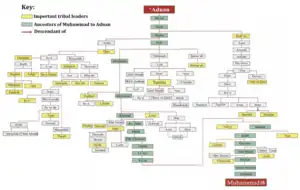Fihr ibn Malik
Fihr ibn Malik (Arabic: فِهْر ٱبْن مَالِك, romanized: Fihr ibn Mālik, fl. c. 230–240 CE), is counted among the direct ancestors of the Islamic prophet Muhammad.[2]: 3 In the lineage of Muhammad from Adnan, Fihr precedes Muhammad by eleven generations.[2]: 3
Fihr ibn Malik فِهْر ٱبْن مَالِك | |
|---|---|
| Born | |
| Died | |
| Children | Al-Harith[1] (ancestor of Abu Ubaidah ibn al-Jarrah)
Muharib[1] Ghalib[1] |
| Parent |
|
Meaning of name
Some writers stated that his name was also "Qarish" (hard, diminutive is "Quraysh"), which fits him being the progenitor of the Quraysh tribe. However most genealogists reject this version.
Ibn Ishaq's account
According to Ibn Ishaq, Fihr defended Mecca against the Himyarite King of Yemen who wanted to transfer the Kaaba to Yemen.[2]: 41
Battle with Yemen
A sharp engagement followed in which Himyar were defeated, and Hassan Bin Kilal Bin Dhi Hadath al-Himyari was taken prisoner by Fihr for two years until he paid his ransom.[2] This story however was rejected by some Muslim scholars who argued that they have never heard of it and that Khuza'a in charge of Kabaa at the time of Hassan Ibn Kilal not Quraysh.[3]
He is the common ancestor of all the ten promised paradise through his sons Al Harith and Ghalib as all of them belonged to the Quraysh Tribe.
Role
Fihr bin Malik led the people of Makkah to fight the armies of the Himyarite kingdom when they came to move Kaaba to Yemen, and succeeded in defeating the army.[4] Fihr bin Malik mobilized a joint force consisting of Quraish, Bani Kinanah, Bani Khuzaimah, Bani Asad, Bani Judham, and several tribes Mudhar.[5] King Himyar Hassan bin Abdu Kalal bin Mathub bin Dzu Hurath al-Himyari was captured, and after three years was released after paying a ransom.[5]
Fihr bin Malik looked after the needs of the pilgrims (Hajjis) who came to Mecca, and as a livelihood he traded with other Arab tribes.[4]
Descendants
From the marriage of Fihr bin Malik with Layla bint Al-Harith bin Tamim bin Sa'ad bin Hudzail bin Mudrikah from Banu Tamim,[5] he had several children named Ghalib (who also had many descendants), Muharib, and Harith,[4] Asad, Awf, Jawn, and Dhi'b.[5] When Muhammad started the spread of Islam, the great tribes Quraish (Imarah Quraish) descendants of Fihr bin Malik who at that time lived in Mecca and its surroundings, are:[6]
Quraish al-Batha' (Quraish of the valley)
- Bani Adi bin Kaab bin Luayy bin Ghalib bin Fihr
- Bani Taim the son of Murrah, the son of Kaab, the son of Luayy, the son of Ghalib, the son of Fihr
- Bani Zuhrah the son of Kilab, the son of Murrah, the son of Kaab, the son of Luayy, the son of Ghalib, the son of Fihr.
- Bani Sahm son of Amr, son of Hushaish, son of Kaab, son of Luayy, son of Ghalib, son of Fihr.
- Bani Jumah bin Amr bin Hushaish bin Kaab bin Luayy bin Ghalib bin Fihr
- Bani Makhzum bin Yaqazhah bin Murrah bin Kaab bin Luayy bin Ghalib bin Fihr
- Ban Abdud-Dar bin Qushay bin Kilab bin Murrah bin Kaab bin Luayy bin Ghalib bin Fihr
- Bani Abdu Manaf bin Qushay bin Kilab bin Murrah bin Kaab bin Luayy bin Ghalib bin Fihr
- Bani Muttalib bin Abdu Manaf
- Ban Abdu Shams bin Abdu Manaf
- Ban Hashim bin Abdu Manaf
- Bani Nawfal bin Abdu Manaf
- Bani Asad bin Abdul Uzza bin Qushay bin Kilab bin Murrah bin Kaab bin Luayy bin Ghalib bin Fihr
Quraish az-Zawahir (Quraish fringe)
- Bani Al-Harith bin Fihr
- Bani Muharib bin Fihr
- Ban Amir bin Luayy bin Ghalib bin Fihr
References
- Watt 1986, p. 434.
- Ibn Ishaq; Guillaume (1955). The Life of Muhammad: A Translation of Ibn Isḥāq's sīrat. London. ISBN 0-19-577828-6.
{{cite book}}: CS1 maint: location missing publisher (link) - "المفصل فى تاريخ العرب قبل الإسلام • الموقع الرسمي للمكتبة الشاملة". shamela.ws (in Arabic). Retrieved 2018-10-19.
- Moenawar Khalil (2001). Complete date of the Prophet Muhammad. Vol. 1. Human Echo. p. 37-42. ISBN 978-979-561-710-5. 9795617109.
- abarī (1988). The History of al-Tabari: Muhammad at Mecca. Vol. 6 of Bibliotheca Persica. Translations and annotations by William Montgomery Watt and Michael V. McDonald. SUNY Press. p. 28-29. ISBN 978-0-88706-706-8. 0887067069.
- Abdul Aziz (2011). Chiefdom of Medina: Misunderstanding the Islamic State. Alphabet Library. p. 208. ISBN 978-979-3064-98-7. 9793064986.
